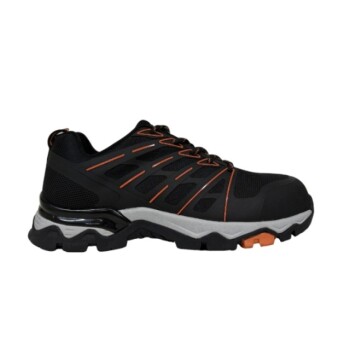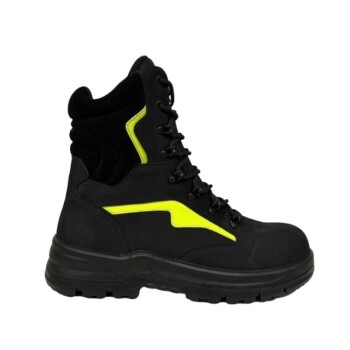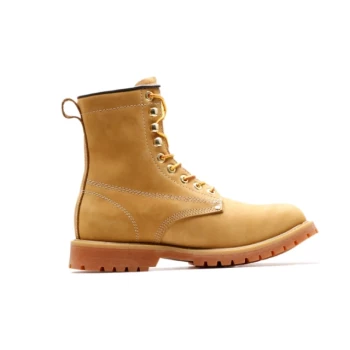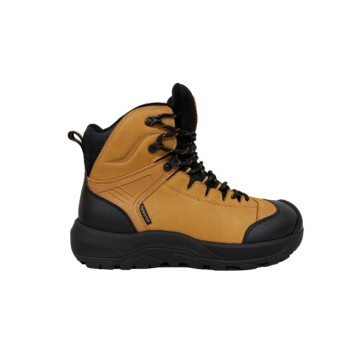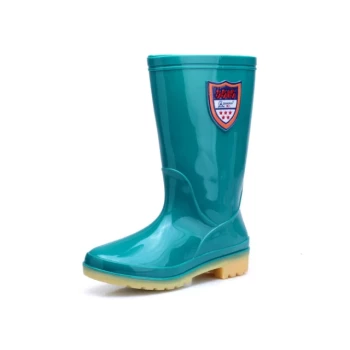Beyond just a smaller size, women's work boots are engineered differently from the ground up. They are constructed to match the specific anatomical differences of a woman's foot, typically featuring a shorter ankle height and a smaller instep. This tailored design provides a fundamentally better fit, which is critical for both comfort and safety during long hours on the job.
Choosing a women's-specific work boot is not a matter of preference; it's a matter of proper engineering. They are built on an entirely different foot model, or "last," to prevent the discomfort, fatigue, and potential injury that can come from wearing ill-fitting men's boots.
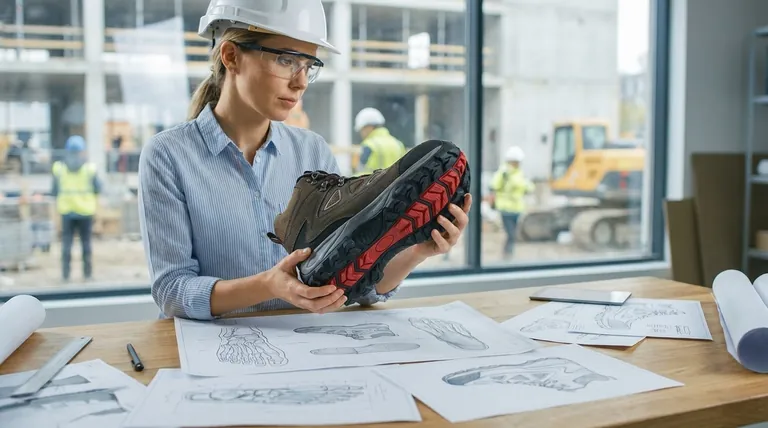
The Anatomical Blueprint: Why Fit is Foundational
A man's boot in a smaller size is not a true women's boot. The core difference lies in the last, the three-dimensional model around which a boot is constructed. A women's-specific last accounts for several distinct structural differences.
A Narrower Heel and Forefoot
Women's feet are generally narrower at the heel and across the ball of the foot relative to their length. A women's last accommodates this, preventing the heel from slipping and the foot from sliding side-to-side, which can cause blisters and instability.
A Smaller, Higher Instep
The instep is the bony structure on top of your foot. Women's boots are designed with a smaller instep area to ensure a snug, secure fit without painful pressure points.
A Higher Arch
Women often have higher arches than men. A boot designed for a woman's foot will provide better, more targeted arch support, which is crucial for reducing strain and fatigue when standing or walking for extended periods.
Core Safety and Performance Features
While the fit is unique, the essential safety and durability features are universal. When selecting a women's work boot, these non-negotiable elements ensure you are protected in demanding environments.
Protective Safety Toes
Reinforced toes are a hallmark of work boots, designed to protect your feet from compression and impact.
- Steel Toes offer maximum protection and are standard in heavy-duty industries.
- Composite Toes are made from non-metal materials like carbon fiber or Kevlar. They are lighter and don't conduct electricity but may offer slightly less impact resistance.
Durable, Task-Specific Materials
The boot's material dictates its performance and lifespan.
- Leather is a traditional choice, prized for its durability, breathability, and ability to mold to the foot over time.
- PVC (Polyvinyl Chloride) boots are made through injection molding, creating a seamless, waterproof, and chemical-resistant shell ideal for wet or contaminated environments.
Slip-Resistant Outsoles
Traction is a critical safety feature. Work boot outsoles are made from materials like rubber or polyurethane and feature deep lugs and specific tread patterns to prevent slips and falls on slick or uneven surfaces.
Specialized Protection
Many work boots offer protection against specific workplace hazards. Common features include waterproofing for outdoor work, insulation for cold conditions, and Electrical Hazard (EH) ratings for protection against live electrical circuits.
Understanding the Trade-offs
Choosing the right boot involves balancing protection, comfort, and job-specific needs. Ignoring these trade-offs can lead to the wrong choice.
The Pitfall of Unisex Sizing
The most significant mistake is opting for a "unisex" or downsized men's boot. While it might seem convenient, the improper fit leads directly to foot pain, reduced stability, and a higher risk of tripping or rolling an ankle.
Steel vs. Composite Toes
While steel offers the highest level of impact protection, it is also heavier and conducts temperature, making it cold in winter. Composite toes are lighter and better for temperature-variable environments but may not meet the safety standards for the most extreme industrial sites.
Specialized vs. General-Purpose
A boot designed for one task may be unsuitable for another. A highly chemical-resistant PVC boot will not offer the same ankle support and breathability as a hiking-style work boot designed for navigating rough terrain.
Making the Right Choice for Your Work
Your specific job environment should be the ultimate guide for your decision.
- If your primary focus is heavy industry or construction: Prioritize a certified steel toe, a puncture-resistant sole, and durable leather construction.
- If your primary focus is outdoor work or agriculture: Look for robust waterproofing, slip-resistant outsoles, and materials that withstand barnyard acids and mud.
- If your primary focus is electrical work: Ensure the boot is explicitly EH-rated and features a non-conductive composite toe and sole.
- If your primary focus is all-day standing on hard surfaces: Emphasize superior cushioning, arch support, and a lightweight design built on a women's-specific last to prevent fatigue.
Investing in a work boot engineered for your foot's anatomy is the most critical decision for your daily safety, comfort, and performance.
Summary Table:
| Feature | Men's Boot (Downsized) | Women's-Specific Boot |
|---|---|---|
| Heel & Forefoot Fit | Often too wide, causing slippage | Narrower for a secure, stable fit |
| Arch Support | Generic, may not align properly | Higher, targeted support for reduced fatigue |
| Instep | Can create pressure points | Snug fit without discomfort |
| Overall Comfort & Safety | Increased risk of blisters and instability | Optimized for all-day comfort and injury prevention |
Get the Perfect Fit for Your Workforce
As a large-scale manufacturer, 3515 produces a comprehensive range of women's work boots for distributors, brand owners, and bulk clients. Our production capabilities encompass all types of safety footwear, from steel-toe leather boots for construction to EH-rated and waterproof styles for specialized trades.
We engineer our women's boots on a dedicated last to match the anatomical blueprint of a woman's foot, ensuring unparalleled comfort and safety. Partner with us to provide your customers with the right fit and the right protection.
Contact 3515 today to discuss your footwear needs and request a quote.
Visual Guide
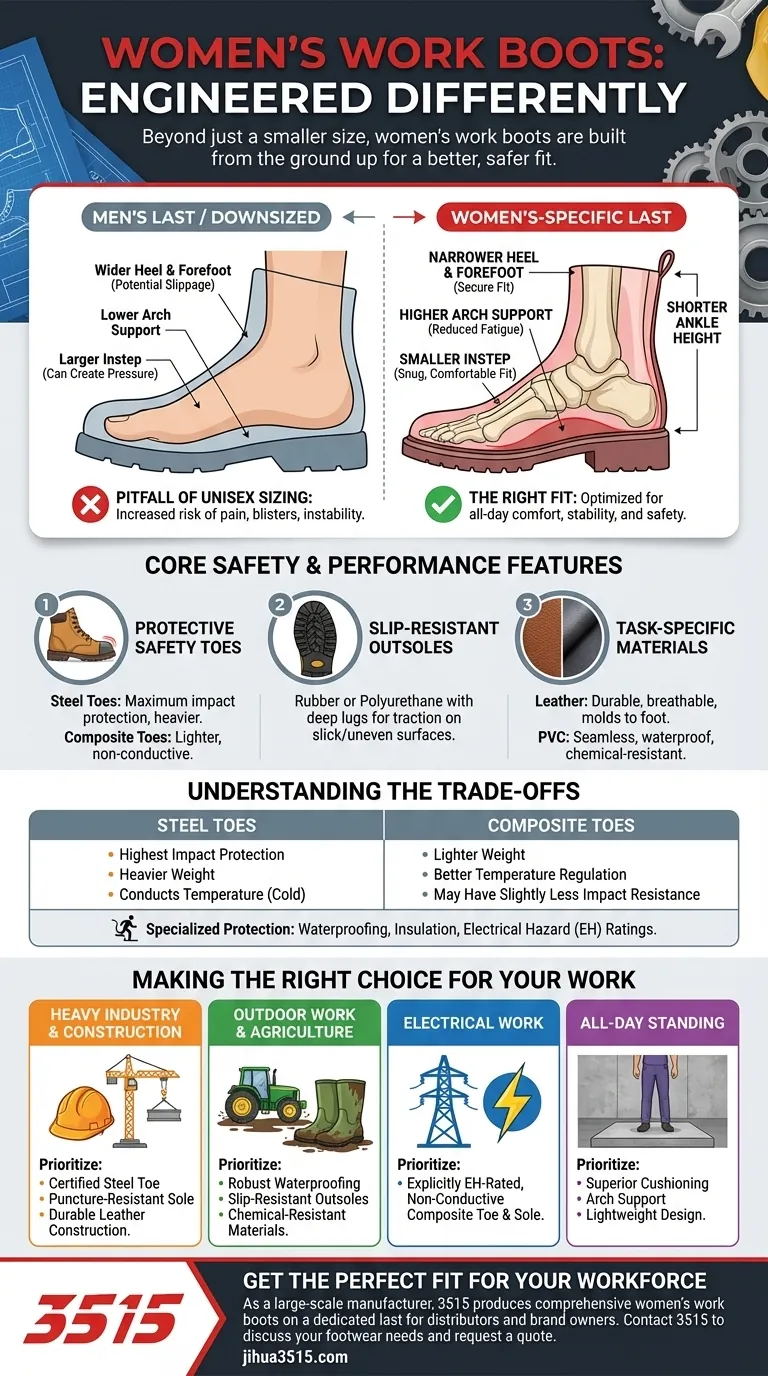
Related Products
- Safety Footwear Wholesale Manufacturer for Custom OEM/ODM Production
- Wholesale Safety Footwear Manufacturer for Bulk & Custom OEM Orders
- Premium Flame-Retardant Waterproof Safety Boots and Shoes
- Premium KPU Injection Athletic Style Safety Shoes
- Wholesale Anti-Smash & Puncture-Proof Safety Shoes Custom Manufacturing for Brands
People Also Ask
- What do heavy duty boots do? Protect Your Feet in Demanding Work Environments
- How long can you wear safety boots? The Lifespan is Determined by Wear, Not Time
- Is it normal to wear shoes in the house? A Guide to Hygiene, Comfort & Culture
- Is safety-toe as good as steel toe? Choose the Right Protection for Your Job
- How do safety shoes contribute to cost savings for companies? A Strategic Investment in Risk and Cost Management



